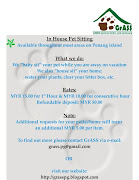By SHARMILLA GANESAN
Nuclear energy is widely used in this country and the AELB is there to ensure that it is done safely.
NUCLEAR energy is not something one would automatically associate with Malaysia; after all, to the layman, atomic energy is usually related to the nuclear arms race, an issue that is rather removed from our shores.
Nuclear energy, however, has a lot more potential than just warfare. As a clean energy source, atomic energy is often hailed as a viable alternative to rapidly dwindling fossil fuels. What many people don’t realise is that nuclear energy is already being used in Malaysia in many ways, in fields as diverse as manufacturing, medicine, aviation, food, and oil and gas industries.
The use of atomic energy, however, is not without its hazards, which makes it necessary for stringent guidelines and enforcement regarding its usage.
This is where a little-known local body comes in: the Atomic Energy Licensing Board (AELB) under the Science, Technology and Innovation Ministry. The AELB is a regulatory body that deals with the safe usage of nuclear power in the country, by issuing licences to those who use this energy source and making sure they adhere to proper usage guidelines.
The AELB’s main task is dealing with safety. According to AELB chairman Prof Datuk Dr Noramly Muslim, this includes both the safety of the workers or individuals involved in using nuclear technology and the well-being of the general population.
“Our licencees are dealing with nuclear technology, radioactivity and radiation, so safety is very important. We have to make sure the operators who are handling the technology are safe, and equally important, that the technology itself is safe,” explains Noramly, who at 68, has had more than three decades’ experience working with nuclear energy.
“So our responsibility is two-fold; firstly, the safety of workplaces that utilise nuclear technology is very important, so we have to regulate how the technology is used and the safety measures put in place. Secondly, we also have to enforce the regulations. If an organisation fails to follow our rules, we have to persecute them.”
 Prof Datuk Dr Noramly Muslim: ‘Our system can detect airborne radiation, so, for example, if there is an accident in Vietnam, we will be able to detect it here.’
Prof Datuk Dr Noramly Muslim: ‘Our system can detect airborne radiation, so, for example, if there is an accident in Vietnam, we will be able to detect it here.’ Constant vigilance
For anyone working in the fields of atomic energy, the nuclear accidents at power plants in Three Mile Island, Pennsylvania, US, in 1979, and Chernobyl, Ukraine, in 1986, are looming reminders of the need to be constantly on their guard. The folks at AELB are no less vigilant.
“To recover from an event like Chernobyl is extremely difficult, and those disasters are part of the reason people still think of nuclear technology as being dangerous,” says Noramly. “But things have changed, and those two events have taught all of us to build in as many safety features as possible. We will ensure that the type of technology they had at Three Mile and Chernobyl will never operate in this country.”
Besides issuing licences to organisations working with nuclear technology, AELB also has monitoring facilities around the country that measure radiation in the region. Called the Environment Radiation Monitoring System (ERMS), the system collects and sends data on radiation levels, thereby allowing AELB to establish a baseline reading of radiation emissions in the region.
“This allows us to detect jumps in the normal levels of radiation, so that we can deal with the situation accordingly. Our system can detect airborne radiation, so, for example, if there is an accident in Vietnam, we will be able to detect it here,” says the board’s director general, Raja Abdul Aziz Raja Adnan.
“This is important because our neighbours have declared that they are going nuclear, and if there are any anomalies in our readings, we will see if we can mitigate in any way.”
He adds that AELB members also periodically go around the country testing the water and soil at different locations to verify the data they are getting from the system. Another precaution taken by AELB is to set up various forms of radiation detectors at entry points into the country, to ensure people do not bring in nuclear sources that are detrimental to public health.
If all this sounds rather irrelevant to the man-in-the-street, think again. AELB currently has about 2,000 licensees, with 11,000 nuclear energy sources around the country. Nuclear technology is already being used in many industries in Malaysia, such as in hospitals, laboratories, oil rigs and shipping companies.
Among these radiation sources are health-related machines in hospitals that emit radiation, the use of various radioisotopes in medical facilities or universities, and industrial devices.
Current uses
A look at the current uses of atomic energy brings up a surprising list. For example, radiation is used in blood sterilisation in pathology labs. Surgical gloves are also sterilised by radiation. In the beverage-making industry, radiation is used to ensure that the volume of liquid in every bottle is exactly the same. The luggage-screening machines in airports use radiation too. Even a humble X-ray machine is, in fact, using nuclear energy.
Such usage is the reason for the AELB’s existence. Raja Abdul Aziz shares that the board’s extremely stringent guidelines are in place to prevent harmful effects from the use of nuclear technology.
“We cannot afford mistakes. Our aim is to ensure that the technology is used safely, and only for peaceful purposes; this is particularly so because nuclear technology can be abused if it falls into the wrong hands,” says Raja Abdul Aziz. As an example, he explains that the radiation used in blood sterilisation can be used to commit terrorist acts.
Accidents or mistakes when handling nuclear technology can also have fatal consequences; for example, a cobalt-60 pencil (used in glove sterilisation) can kill a person within a few hours if left in their car, says Raja Abdul Aziz.
AELB’s role as a monitoring body becomes even more significant in light of the fact that nuclear energy is an increasingly important source of power. Raja Abdul Aziz calls atomic power the “energy of the future”, citing how most countries around the world are opting for it.
“Countries like Japan are now running 30% on nuclear power, even after going through an atomic attack. Even oil-rich countries in the Middle East are exploring it, and India is already a powerhouse. China, meanwhile, is manufacturing nuclear power while also absorbing technology from the West,” he says.
Noramly adds that with the drafting of the proper nuclear power policies, Malaysia has the capability to go nuclear within five to 10 years, thereby lessening the reliance on depleting oil and gas reserves.
Despite the vital role it plays, the AELB is akin to the proverbial prophet who is not recognised in his own country – it has made a name for itself internationally for its high standards, and yet remains virtually unknown in Malaysia. This, in fact, can be said to be the case with the entire nuclear energy field here.
“People don’t realise how much capacity and trained personnel we have,” says Noramly. “People have been coming here from abroad for training, which says a lot about our standards.”
In fact, AELB’s monitoring facilities and regulatory practices are considered to be one of the best in Asean. This is even recognised by the International Atomic Energy Agency (IAEA), an international organisation that reports to the United Nations’ General Assembly and Security Council. Of the seven groups of advising director-generals at IAEA, three members are Malaysians, including Raja Abdul Aziz himself.
Noramly, meanwhile, has served as IAEA’s deputy director-general for six years in the late 1980s, and was stationed in Vienna to coordinate assistance to Chernobyl during the nuclear disaster. At 45, he was the youngest deputy ever to be elected.
Noramly was also recently endorsed by the Malaysian government as a candidate for the IAEA’s director-general post. (The IAEA director general oversees a global inspectorate that seeks to detect and deter covert diversions of nuclear energy to bomb-making and to promote peaceful uses of the atom, in keeping with the Non-Proliferation Treaty.)
Nuclear inspectors
Furthermore, there are currently five Malaysians from AELB serving as nuclear inspectors in various parts of the world. This includes two who are inspecting North Korea for nuclear sources.
Raja Abdul Aziz shares an example of how tight AELB’s measures are compared to other nations. “Naturally occurring radioactive material (such as amang, a thorium-rich by-product of tin-mining) is not regulated in places like Australia, and the IAEA does not stipulate that it should be.
“Here, however, we register the areas and sometimes license the operators. This way, whenever there is some sort of mishap, like flooding, we know exactly how many radioisotopic materials there are, so that we can retrieve them. Now, the IAEA is also looking into implementing similar measures.”
Noramly sums it up eloquently: “I would like others to know that we have a credible organisation that has the international capacity, competency and expertise to handle nuclear energy. We already have the ability; what is important is for the country to have confidence in us.”











































No comments:
Post a Comment